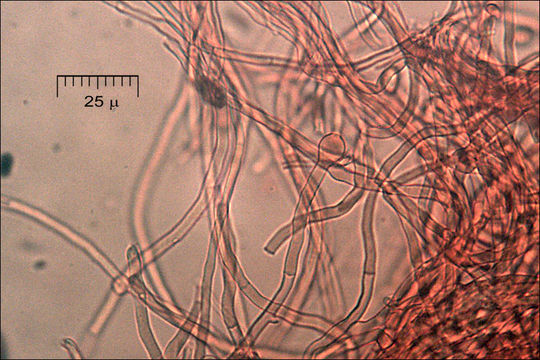Слика од Crepidotus mollis var. calolepsis

Опис:
Slo.: zdrizasta postranica - Habitat: alpine valley, river bank, occasionally flooded terrain, locally almost flat, alluvial, calcareous ground; river bank vegetation mostly consisting of Salix eleagnos, Picea abies and Fagus sylvatica; humid air and ground, partly sunny, partly protected from direct rain; average precipitations ~ 3.000 mm/year, a average temperature 7 - 9 deg C, elevation 540 m (1.770 feet), alpine phytogeographical region. - Substratum: dead wood, stump of a fallen Salix eleagnos. - Comments: Growing in a group of many pilei; pilei up to 4.5 x 3 x 0.6 cm, most of them smaller; pilei have gelatinous cutis easily peeling off, surface not sticky; stipe rudimentary or absent, white mycelium present at the point of attachment; taste mild, indistinctive; smell indistinctive, eventually slightly mushroomy; flesh quite firm and pliant; SP faint, possibly brownish. I follow taxonomy given in Krieglsteiner (2001) (Ref.:4), which distinguishes two varieties of Crepidotus mollis, var. mollis and var. calolepsis. I decided for the latter because of redish-brown fibers similar to scales on the surface of pilei. The surface was also not slimy. All my finds of Crepidotus mollis up to now have had slimy and glabrous pilei surface. Measured spores are a little longer than usually with Crepidotus mollis var. mollis (see picture 2M), which also speaks in this sense (Ref.:4). But these fibers may eventually be a consequence of a few warm and dry days before I found the pilei, although they didn't look dried or weathered. The Crepidotus mollis var. calolepsis is considered a separate species by some authors. They divide it into two varieties Crepidotus calolepsis var. calolepsis (spores 7 to 10 microns long) and Crepidotus calolepsis var. squamulosus (spores 8 to 12 microns long). Spore domensions and hypha without clamps exclude Crepidotus applanatus, which eventually may also be a candidate for this find. - Spore dimensions: 7.5 [9.1 ; 9.7] 11.2 x 5 [5.8 ; 6] 6.8 microns, Q = 1.3 [1.6] 1.9; N = 45; C = 95%; Me = 9.4 x 5.9 microns; Qe = 1.6. No hypha clamps were observed. Olympus CH20, NEA 100x/1.25, magnification 1.000 x, oil (spores); NEA 40x/0.65, magnification 400x (hypha, 'stipe' mycelium) in water, Congo red; all live material. AmScope MA500 digital camera. - Herbarium: Mycotheca and lichen herbarium (LJU-Li) of Slovenian Forestry Institute, Vena pot 2, Ljubljana, Index Herbariorum LJF - Ref.: (1) J. Breitenbach, F. Kraenzlin, Eds., Fungi of Switzerland, Vol.5. Verlag Mykologia (2000), p 300. (2) S. Buczacki, Collins Fungi Guide, Collins (2012), p 390. (3) R. Phillips, Mushrooms, Macmillan (2006), p 269. (4) G.J. Krieglsteiner (Hrsg.), Die Grosspilze Baden-Wrttembergs, Band 4., Ulmer (2001), p 436.
Информации за изворот
- лиценца
- cc-by-nc-sa-3.0
- авторски права
- 2015 Dr. Amadej Trnkoczy
- фотограф
- Dr. Amadej Trnkoczy
- изворно
- изворна податотека
- посети извор
- соработничко мреж. место
- CalPhotos
- ID


